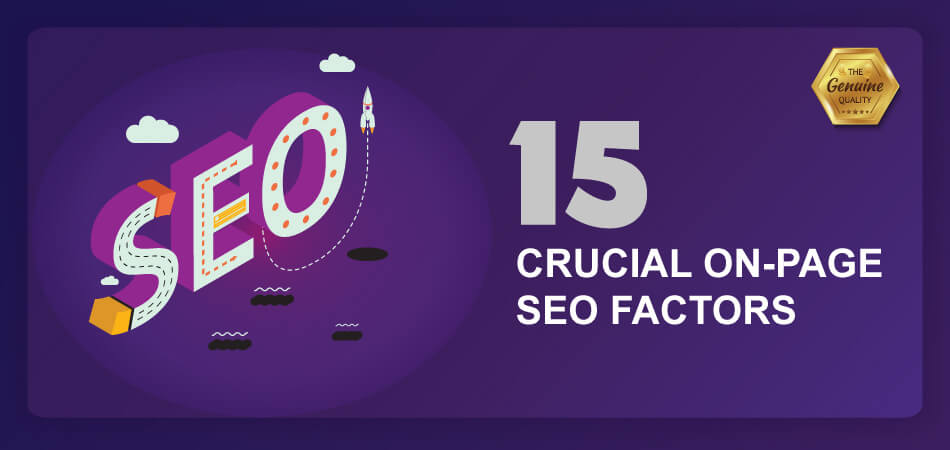Giant Marketers is one of the fastest-growing and leading digital marketing company in Bangladesh. Its primary goal is to help clients to grow big with...Read more
Are you struggling to improve your site ranking and reach your potential customers? Probably, you’re making some common SEO mistakes that have negative impacts on your site’s ranking.

From small to larger, most companies make some similar mistake. As an SEO professional, I have seen this happen many times. Although SEO is one of the most successful ways to drive organic traffic and earn profits; If you make a mistake, it can be just the opposite.
You have to face a harsh truth about SEO that Google won’t spare your site if you make any mistake. In contrast, when you follow Google’s rules and guidelines accurately, it will reward your site with top rankings.
Therefore, to help you not to make any common mistakes, I’ve summarized 13 SEO mistakes to avoid in this guide. Check the list and ensure you won’t repeat any of these ever. So, let’s get started with the discussion.
Most Common 13 SEO Mistakes to Avoid
The digital marketing world is constantly evolving, and so are the SEO tactics. Over time, search engine algorithms, market conditions, and customer preferences are changing.
Thus, it becomes essential to keep track of the latest updates and best practices of SEO to avoid any blunders. So let’s find out the most common SEO mistakes that you should avoid.
1. Not Focusing on the Audience’s Search Intent
SEO is the audience’s voice, and understanding their search intent is one of the primary principles of SEO. The underlying goal of SEO is to help the search algorithm connect the audience to the updated and relevant content of their query.
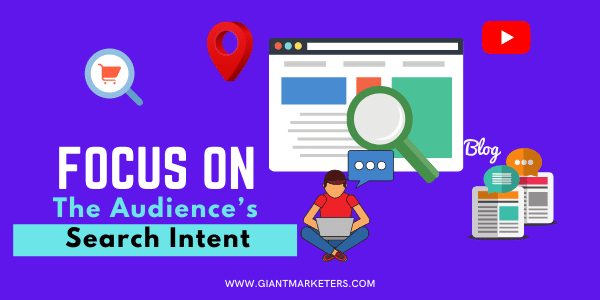
Unfortunately, people often fail to understand what their audiences are looking for and their search intentions. Generally, when people go to a search engine, they search in three different types. These are-
- Transactional: This implies when someone wants to buy any product or service and take action on a website soon. Such keyword terms include where can I buy, subscribe, etc.
- Informational: It refers to when an audience searches for any information like 15 Best Keyword Research Tools [2022].
- Navigational: Navigational means when a user directly uses the name of a website while searching. For example, Amazon, CNN, etc. That means users want to go to a specific website that is known to them.
That means you should understand, are they looking to buy something or learn something? So, while defining any product or service, it is necessary to consider the terms your customer will use while searching for any product or service.
At the same time, keep in mind that your readers expect instant responses and real-time results of their queries. So, see the following tips to understand the search intent much better.
- Understand the macro trends of markets where your consumers visit.
- Utilize the history and real-time data to understand their behavior changing.
- Then create a map of your findings to the keyword selection and strategy.
2. Keyword-Related Mistakes
A number of people don’t care about considering what people are searching for; they just focus on creating content. Which ultimately results in nothing. You should do keyword research to know the audience’s search intent for your particular topic.
In fact, through keyword research, you can determine the user’s search volume for that specific topic you want to write for. You can do one more thing, that is, look out for the competition for that particular keyword.
With too high competition, there are fewer chances of ranking on the first page of the SERP. In this situation, keyword research acts as a balance between search volume and competition. Here, I’ll share the common mistakes that people make while conducting keyword research.
Optimizing for the Wrong Keywords:
Undoubtedly, this mistake is the big one, and it’s really unfortunate that even in 2022, optimizing for the wrong keywords is still a common issue. You must know that your page’s primary keyword is the reason to drive organic traffic to your site. Without proper keyword research, you can’t even think about ranking on search engines.
Inappropriate Using in Content and Headlines:
Keywords help search engines to understand the context of your page. In addition, they contribute to ranking and show up your web pages in front of searchers. So, if you fail to utilize the keywords in your content, headlines, or any other required places, everything will simply go in vain.
So, the moral is, do not just pick keywords and throw them wherever you want in the content. Instead, do the research and make proper use of them and optimize them strategically throughout your web page.
Keyword Stuffing:
Keyword stuffing can trigger a Google penalty that will be hard to recover.
Often, many companies forget that they are creating content for their audience first. That’s the main reason behind packing the entire content full of keywords. As a result, the content becomes unreadable, unnatural, clunky, spammy, and seems like it is written only to improve ranking.
Keyword Cannibalization:
You should not target the same keyword for creating multiple pages. This thing can confuse Google, as Google can’t decide which one to show. In that case, you can delete content that is not relatable or updated and create new content with specific keywords.
3. Content Related Mistakes
A study by Databox found that, when it comes to SEO, most companies under-invest in content. And this is the biggest mistake because having quality content is the key to drive more traffic. You may well optimize your content, but you will face a more challenging time getting them into action with insufficient information and writing.
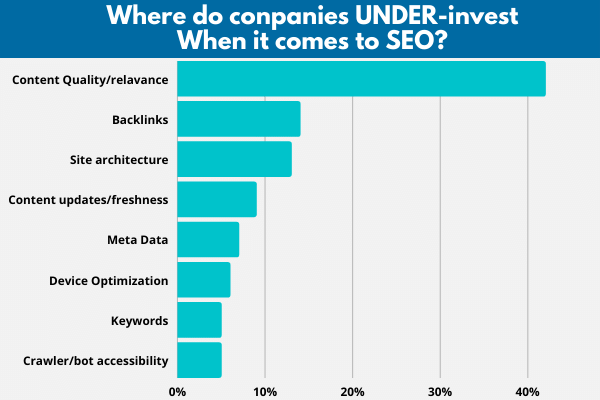
Google serves their users with the most relevant content in terms of their search queries. That means, if your content can’t meet the user’s needs, it won’t stand out and rank well. Here are some content-related mistakes that you should avoid.
Poorly Written Content:
Generally, people look out for quantity over quality, which results in poorly written content. By hiring low-paid article writers and using content spinners, many website owners ensure a larger amount of content on their site. But you should remember, people are interested in reading quality content with accurate and original content.
So, focus on writing the best piece of content for the target keyword that you want to rank for. To do so, follow the tips.
- Make sure your SEO and content strategy are aligned.
- Create several types of content. It will ensure meet up different needs and SERP layouts. Look out for Visuals, text, videos, etc.
- Hire content writers who are capable of producing original articles. You’ll probably have to pay them a bit more, but when it results in more conversions, your investment will be worth it.
Not Following EAT:
EAT implies Expertise, Authority, and Trustworthiness. That means whatever you are writing, you have to be an expert on that particular topic. Otherwise, you can’t provide authentic and relatable information to your audience. So, here is how you can ensure EAT through your content.
- For each editorial content, use the author’s name, image, and biography.
- Include your social media profile and interact with your audience.
- Tell your story through your webpage to connect with the readers.
- Ensure transparency throughout your website.
- Make sure your website is secure.
Publishing Duplicate and Thin Content:
Semrush conducted research by collecting data from 1,00,000 websites and over a million pages. This research shows 50% of the website consists of duplicate content issues.
Some people also use tools to spin other website’s content into a new shape. But the thing is, using such tactics, thin and duplicate content simply doesn’t work for any site.
Let’s see where the duplicate issues appear mostly in-
- Homepage duplication
- URL duplication
- Using similar content of different webpages
- Duplicate title and meta tags.
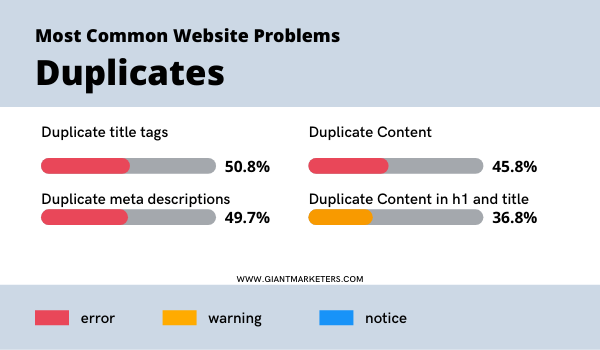
Google considers duplication and plagiarism as spammy practices and highly discourages this content. So, you’ve to avoid such bad practices and focus on the following good practices.
- It’s worth it to invest in creating meaningful and original content with proper information.
- Create strong and catchy headlines that match the content.
- Never mislead readers by providing something that doesn’t go with your content.
- Create something that the reader can relate to, also quote trustworthy sources to provide enough resources.
Not Creating Link Worthy Content:
You should focus on building valuable content so that people are eager to link to it. If you are unable to create unique content, the visitor’s impression will not be that good. Also, people won’t be likely to share your content.
Not Updating or Deleting Old Poor Content:
Everything is not about creating unique and new content. You should also look out for your old content. Your poorly written old content can hold back your SEO effort even after all the new content is good.
- Frequently review your older content and update them to make them up-to-date.
- Use content audit tools like Google Search Console, SEMrush Content Audit, etc.
- If the content is not at all deserving, there is no point in keeping it on your site. Better hit delete.
4. NLP Optimization
NLP means natural language processing that is a branch of artificial intelligence. It assists Google to read and understand the context of words and tone of any web page. BERT and SMITH are two NLP models of Google which work hand in hand.
Actually, BERT has some limitations, as it can only understand short documents and is not suited for long-form documents. Therefore, the SMITH algorithm has been introduced.
It can effectively capture the full passage and compare sentences before, after, and in separate paragraphs. Also, let Google capture the user’s query’s exact answer and feature it on the SERP’s front page. In this way, SMITH can better interpret the documents and bring the content out for showing the reloaded results.
So, the main point is, after the new update of SMITH, if you want to rank your page, you should focus on SMITH’s roles.
Now, you may be wondering about the processes of NLP optimization. So, here they are-
Keep the Content Natural and Meaningful:
Write your content as naturally as possible. Therefore, while writing, keep the human in mind, not the search engines. In fact, focus on creating valuable content for your audience with which they can relate.
Structure of Content:
Use simple sentence structure for providing any answers. Wisely connect questions with the answers. Try to avoid using flowery language and make sure to provide one idea per sentence. Be specific first, and then start explaining in detail. Use an adequate number of LSI and make them bold. Also, you can bold the crucial points or features.
Quality and Rich Content:
Your content should be rich enough to provide all the information related to the search query. Prioritize providing longer and quality content with adequate information than your competitors. Try to avoid fully depending on tools as it can hamper the content quality. You can make use of them to compare the percentage of your content with others.
Implement On-Page SEO Tactics:
Till now, some people rely on outdated SEO tactics, which don’t make any sense in 2022. NLP continues to impact search engine results, so, you should focus on structured writing and formatting the content. Only then your content can convey additional context for NLP to understand.
So, here are the tactics that you should follow-
- Use an inverted pyramid structure for the most important information.
- Include header tags like H1- H6 to break up the content into sections.
- Input the lists with bullet points and numbers. It will make the content scannable for the audience. In addition, it can increase the chances of getting featured snippets.
- In 2022 the link structure becomes more important than before. Evaluating the internal link context can boost the power of each page.
- To avoid unnatural links, use the backlink monitoring tool from SE Ranking.
Use the Google NLP API Tool:
Google created a great tool called Natural Language Processing to examine any text and get insights from unstructured data. With the help of this tool, you can take your content to the next level. It will let you know how readable, relatable, and understandable your content is.
5. Mistakes Related to Title Tags and Meta Description
Title tags and meta descriptions both tell the search engine and visitors what your web page is all about. Also, they show up in your SERP snippet, which means they act as an ad for your web page. This is where you can persuade the audience that your page is the one that they should click on.

Both these tags work as a golden opportunity to tilt the field in your favor. But, unfortunately, people make some huge mistakes with both these tags. Here we will show the mistakes.
Leave These Fields Empty:
Often people leave both these tag fields empty, and Google fills them up. But, it may not be as good as the words you would have chosen. Therefore, filling these fields and optimizing them by yourself, have a chance to shape your SERP the way you want to.
Keyword Stuffed Page Title and Meta Tag:
Stuffing the title tag and meta description with keywords won’t make any huge difference in the SERP rankings. Rather, it works as a mistake that Google doesn’t value much.
You should present your page title and meta description in such a way so that it looks natural and can draw the user’s attention. And you can do this simply using the target keyword once. So, use your keyword where it fits naturally.
Using the Same Title Tag and Meta Description for Every Page:
Using the company or website’s name for each page’s title is a damaging mistake for SEO. Remember, every page of your website should have a unique, specific, and relevant title and meta description.
Do Not Follow the Appropriate Length Size:
Often most people use longer title tags and meta descriptions which Google truncates. That means your entire meta and title tag won’t be displayed on the SERP. Therefore, to avoid truncation, you should follow the exact length limit.
- Google uses 600 pixels for title tags, so keeping the line between 50-60 characters will be ideal.
- Google truncates meta tags above 920 pixels. Thus, use 155-160 characters to write meta descriptions to avoid truncation.
The best thing will be following the title tag and meta description best practices. This way, you can create great and unique titles and snippets for each page of your website.
6. Image Tags
Web pages with stunning and relatable images look more engaging to the readers. And what if these stunning images are invisible to the search engines? Yes! That’s another technical fault that many people do by not including image tags. Let’s have a closer look at all the mistakes related to image optimization.
Missing Alt Text:
Alt text makes your content image visible to search engines, and they can easily identify the relevancy of your image and content. So, if your image doesn’t consist of any alt text, it will be difficult for Google to find and rank it.
Here’s how you can optimize your image with alt text.
- Add the target keyword to your alt text after uploading images to the CMS. But, remember not to stuff the alt text with keywords.
- Write a detailed description of the image along with the keyword. Like this “<img src=”kwe.png” alt=”Moz Keyword Explorer tool for SEO keyword research”>.”
Not Including Caption:
Most businesses often fail to take advantage of image captions by not including them. By doing so, they damage the content credibility with search engines. Keep in mind, both alt text and image caption are indexed by search engines. Besides that, it provides positive impacts on the user experience. So, ensure to include a brief description of your image just beneath the image.
Using Irrelevant Images:
It’s a big mistake that can hamper the overall content quality. You should pay proper attention while choosing content images. They should match with the content objective of the particular page. The images should be able to convey what your content is all about.
7. Page Experience
Google analyses page experience in terms of four pillars of loading, user annoyance, security & privacy, and lastly accessibility. That means you can provide value to the users by ensuring these four pillars for your web pages.
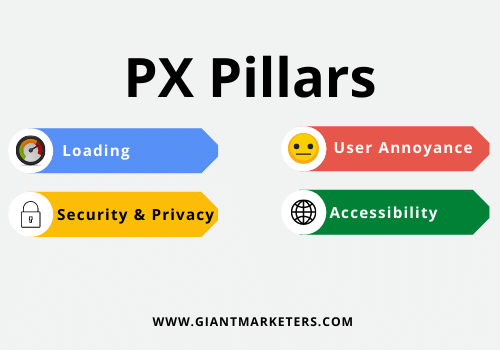
For loading, Google uses Large Contentful Paint (LCP) and First Input Delay (FID). Google has CLS that means Cumulative Layout Shifts for the user annoyance pillar. Now, for security and privacy, Google requires every page to use the HTTPS protocol and safe browsing systems. And lastly, the mobile-friendliness of web pages covers the accessibility pillar.
So, let’s figure out how to improve each of these matrices to avoid any mistakes.
Core Web Vitals:
The first three metrics of Core Web Vitals are LCP, FID, and CLS. These are the set of metrics that every site owner should apply to ensure a better user experience. So, let’s have a look at how they work.
Large Contentful Paint: LCP implies the duration a page takes from clicking on a link to seeing the entire content on-screen. Usually, users don’t like pages that take a longer time to load. So, what can you do to improve your site’s LCP? Well, it’s pretty simple.
- Remove the unnecessary third-party script.
- Upgrade the web host
- Remove large page elements
- Set up lazy loading.
- Minify the CSS.
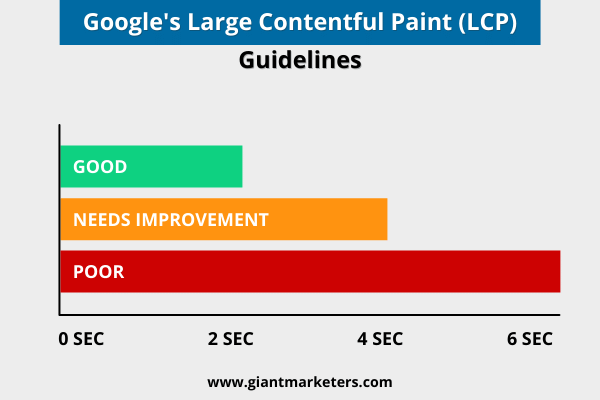
Google has a specific guideline for LCP, which breaks the speed down into three buckets. From the above image, you can get the three buckets. You have to ensure each page of your site hits LCP within 2.5 seconds. To check the LCP score, you can use Google PageSpeed Insights.
First Input Delay: Technically, FID measures the actual time a page takes to happen something on it. In that sense, this metric is also a page speed score. But, actually, it goes one step further and measures the time a page takes when a user does something on it.
For a blog post or news article where people only scroll the page or zoom it in and out, FID is not that big deal. But, it is a huge thing for the sign-up page, login page, or any other pages where the users need to click on something. Just like the LCP, Google also has some criteria for FID. To better understand, see the following image.

Now that you have understood the FID guideline, do follow the below tips to ensure an improved FID score for your site’s pages.
- Minimize or defer your JavaScript on your page.
- Remove all the non-critical third-party scripts.
- Use a browser cache.
Cumulative Layout Shifts: CLS looks for the visual stability of your page when it loads. While loading, if your page’s elements start moving, that means your page has high CLS. And having higher CLS is a bad thing for your page’s user experience. So, let’s see the specific criteria that Google set for CLS are-

Now, for minimizing CLS of your site, you should-
- Set the size attribute dimensions for Video, infographics, images, GIFs, or other media.
- Ensure ad elements have a reserved space.
- Add a new UI element below the fold.
You can check out these tools to measure and monitor your page’s Core Web Vitals score.
NO Intrusive Interstitials:
Many site owners use intrusive interstitials to trick the readers and convince them to do something that they don’t want to. These include showing pop-ups covering the entire screen, displaying a standalone interstitial, and using a layout over the content.
Ultimately, this trick hampers the user experience by making the content less accessible. Therefore, Google devalues pages with intrusive interstitials on mobile. So, before thinking about using these tricks, keep in mind Google penalties.
Mobile-Friendliness:
Google considers mobile-friendliness as a ranking factor, as now most users use mobile for searching anything. Do you know that more than 50.71% of traffic comes from mobile devices? Therefore, it is essential to ensure the site’s mobile friendliness. So, outline the steps to design your site and make the user’s journey easier.
- Measure the effectiveness of your site to ensure that it is ideal for mobile users. You can test it by using this mobile-friendly test tool.
- After that, select a theme, template, or design that is consistent for all mobile devices.
- Never implement your mobile version site on a different domain, subdomain, or subdirectory. It is the biggest mistake that the site owners make.
HTTPS:
HTTPS stands for Hypertext Transfer Protocol Secure. It uses an SSL (Secure Socket Layer) certificate to establish a connection between the search engine and the server. So, if you are still using the old HTTP version, it can affect your ranking factor.
You should secure your site by switching to HTTPS to achieve more authority, branding, and improved search rankings. Let’s see how to do this-
- Install a free SSL certificate.
- Manually enter all the non-HTTPS URLs of your website domain.
- Ensure all of them have been 301 redirected to the HTTPS version.
- If you are using WordPress, use the Really Simple SSL plugin. It will automatically detect and configure your website to run over HTTPS.
Safe Browsing:
Google uses safe browsing to alert users about harmful or dangerous content. So, if your site is not safe, users won’t visit your site as Google will send alerts to them. In the following image, you can see the total number of browser warnings Google shows to the users on a weekly basis.

So, how can you ensure keeping your website safe? Not to worry, I’ll show you the process.
- Set up Google Search Engine Console on your site; it will monitor the site.
- Update your plugins and implement HTTPS.
- Ensure about the unwanted software policy.
8. Link issues
Links contribute greatly to SEO to make a difference in your search engine ranking. Thus, web owners often focus on the number of links over the quality. Here they make a big mistake. Instead of focusing on the relevant and well-ranking websites with strong reputations, they run after the number.
Not Using Anchor Text for Internal Links:
In 2022, using CTA like this post, click here to link, can cost the opportunity of tailoring the anchor text. But the sad part is most of the site owners use CTA as anchor text to increase clicks. You should use the anchor text for internal linking wisely without forcing the user.
Using Same Anchor Text for Each Link:
Optimizing anchor text is necessary, but using the same one for each link to a page is not good for SEO. This thing can hurt your site with search engines as it seems spammy. So, the best way is to mix it up by creating variations on the phrase and make it more natural. Therefore, avoid using the same anchor text more than 50% of the time.
Buying Non-Authoritative Backlinks:
Backlinks are the most essential ranking factor, and that’s why more often, people buy links to boost the website ranking. And this mistake leads the site to end up with a Google penalty. This mistake wastes their money as well as ruins the chance of ranking on the SERP.
So, if you want to pay money for buying links, I’ll suggest investing that money in a reputable SEO service company. They can acquire top-tier links without breaking any rules, and do not waste your money.
9. Not Fixing Broken Pages
Broken links are much harmful to your site, whether they are internal or external links. Three big issues related to broken links and these are-
- User redirects to a 404 page instead of useful information. As a result, you will face an instant traffic dropdown with an increasing bounce rate.
- Audiences will perceive your website as low quality. Thus, you will suffer from lower conversion rates.
- If your website has a ton of broken links, Google will find it difficult to crawl or index your pages.
In that case, you can use some tools to recover this phase. There are
- SEMrush site audit tool,
- Broken link checker from Screaming Frog,
- link checker plugin, etc.
10. Using Incorrect Redirects
When you want the users to permanently redirect from the old or deleted page to your site’s new page, you should use a 301 redirect. These redirects help the users taking to the new page to avoid ending up with an error. Also, they pass on link equity from the old page to the new one.
But instead of using 301 redirects, some people are still using a temporary 302 redirect. As a result, they lose out on the coveted link equity. Therefore, it is essential to know which redirects you are using. Also, ensure that one URL turns to another without causing any delay along the way. To check your site’s redirects, you can use the ScreamingFrog SEO tool.
11. Not Telling the Search Engines Which Pages to Crawl
To help search engines for crawling and indexing all pages of your site, internal linking is a great strategy. When crawlers reach one page that links to other pages, they will follow those page links also. But, site owners make a common mistake by not having an XML sitemap. Generally, it links to all the pages that you want in the search results.
So, you can include pages in the XML site map that you want in the search results. The rest pages will go in a robots.txt file. You can use a sitemap generator to create an XML site map.
Here is another mistake that site owners often make related to crawling.
Unintentionally Blocking Search Engines from Crawling Your Content
For blocking some pages from crawlers, a robots.txt file works effectively. But some unintentionally or accidentally block crawlers to crawl pages that they want to. As a result, your page won’t show in search results.
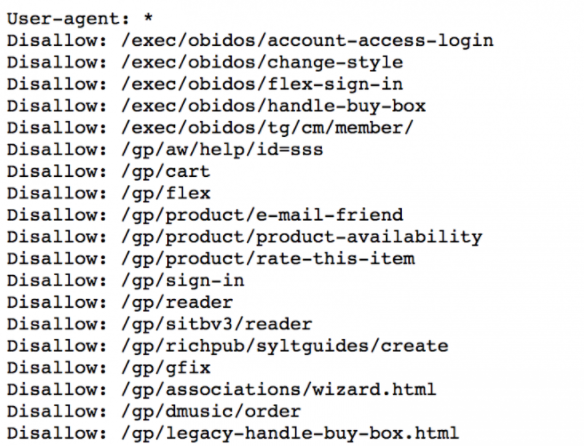
To fix this issue, look out for the robots.txt file. Then type in your website’s URL and add /robots.txt to the end. After that, disallow the pages you want to block from the crawlers.
12. Not Optimizing Local Search
If your website focuses on a certain city’s or region’s customers, it’s essential to optimize the site for local search. But the fact is, many site owners haven’t focused on optimizing their site with local SEO yet. Here I am going to show some common local SEO mistakes that every site owner should pay attention to.
Not Using Google My Business:
Still, there are lots of businesses that are not using Google my business and stay behind in the competition. All businesses should have Google my business set up for each location they operate in. Also, the profile should be monitored, maintained, and updated regularly. Because currently, this thing becomes a huge factor for local SEO.
NAP Inconsistency:
NAP stands for name, address, and phone number, which are the identity of your website and social media profile. Using different and conflicting information will confuse Google and will suppress you in the ranking. Therefore, you should keep consistency while using NAP throughout the Internet.
Add your NAP on Yelp, Merchant Circle, Foursquare, Google My Business, and other local-based sites.
13. Not Utilizing Analytics and Tools
SEO doesn’t mean only having massive amounts of traffic; it is also about the conversion rates. Many times, lower traffic converts better and drives quite a few sales. In contrast, with huge traffic, some sites get bummed and can’t rank well. Therefore, it is necessary to utilize analytics and tools to track the traffic along with the conversions.
Using the analytics package, you can set up the conversion tracking for all your keyword phrases and see the best-produced results by comparing them against each other. In this way, you can optimize your entire site and identify which efforts are worth focusing on.
Some essential metrics of your website that you should take care of are-
- Organic traffic
- Pageviews,
- Conversions,
- Bounce rate,
- CTR, and
- New v/s returning visitors.
Final Thoughts
Every site owner makes mistakes and frankly speaking, it’s ok to make mistakes, as you can’t do everything 100% correctly. But, that doesn’t mean you keep making these mistakes over and over again.
You should learn from your mistakes and try to avoid these things further for getting a better search engine ranking and traffic.
In recent years, SEO is evolving a lot with huge updates. Based on these recent updates, I’ve compiled these 13 SEO mistakes to avoid in 2022. Hopefully, this guide will help you with better results.
So, if you found this guide helpful, you can share your thoughts with us using the comment section below. Also, for any kind of SEO-related queries and services, do Contact Us. we’re here to help grow your business online with our best resources.

Giant Marketers is one of the fastest-growing and leading digital marketing company in Bangladesh. Its primary goal is to help clients to grow big with result-driven strategies and 15+ years of experience in the industry
- Latest Posts by Giant Marketers
-
Is Paying for Monthly SEO Services Really Worth It?
- -
Is Affiliate Marketing Worth It?
- -
Which Is Better Local SEO Or Paid Search?
- All Posts


